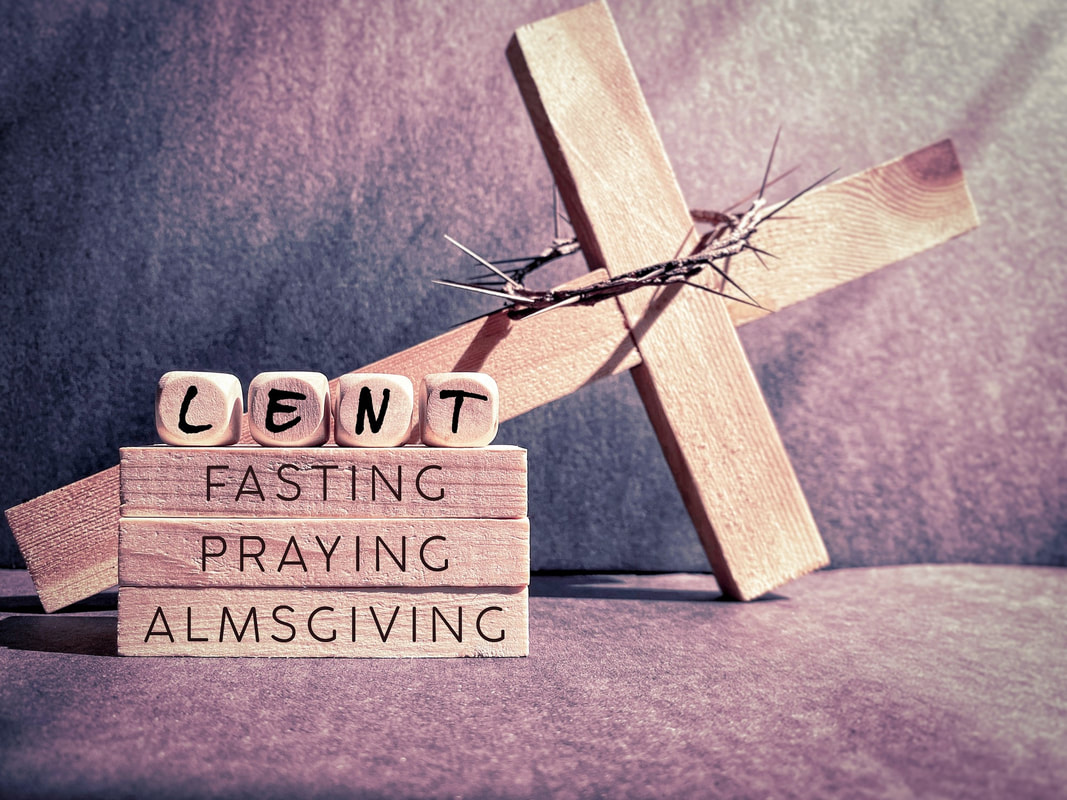|
We are well on our way into the 40 Day journey of Lent. The hearts, hugs and kisses of St. Valentine’s Day have been put away, the ashes from Ash Wednesday have disappeared, Rice Bowls are in the narthex, and our churches are dressed in purple. Lent is indeed here.
The 3 pillars of Lent - prayer, fasting and almsgiving - could also be called the 3 Pillars of Love. In fact, each of the 3 pillars of Lent are invitations to grow in and participate more fully with Love. As St.Thérèse of Lisieux said, “Do not imagine that Love can be found without suffering, for we carry with us our human nature; and yet, what a source of merit it is!” It is these 3 pillars that present us with concrete ways to enter into Jesus' own path to the cross, by overcoming ourselves. The first pillar, Prayer, unites us to Love, aka God. St.Thérèse reminds us that prayer doesn’t have to be complicated, just consistent. “For me,” she writes, “Prayer is a burst from my heart, it is a simple glance thrown towards heaven, a cry of thanksgiving and love in times of trial as well as in times of joy. Prayer is something noble, supernatural, which expands my soul and unites it to God.” Prayer draws us into the life of God. If God is present, then Love is present. If Love is present, God is present. “To abide in love is to abide in God.” (1 John 4:8) To abide means to follow, to be a disciple. There is simply no way to abide in love without prayer, which puts us in close and constant contact with Love. Abiding in love, remaining in God and acting in accord with his will, is beyond our ability without prayer. Fasting, the 2nd pillar, is a direct result of prayer. Although fasting is typically associated with refraining from food or drink, a deeper understanding of fasting is that it is a position of self-restraint, self-discipline, of reminding ourselves of our need for God. Fasting can be practiced with the body, in eating only certain foods or not eating other foods, but it also calls us to the deeper level of spiritual and emotional fasting. Fasting physically prepares us to fast in other ways, such as from behaviors and emotions that destroy and are not life-giving, that are not part of God. It calls us away from self-worship through inviting us to refrain. When we can fast, we can also see the needs of others. We become other-focused, one of the traits of true love. The 3rd pillar, almsgiving, calls us to remember that all we have is a gift. Love calls us to use our gifts in the service of others, especially material goods. We learn to distinguish between needs and wants, and to remember those who are vulnerable. Sharing what God has given us with those who need it is an imitation, on a lower level, of what God does for us. Just as there is no lack or deficiency in God, but he gives us everything out of his own abundant life, so, too, we are called to imitate his generosity by sharing what we have ourselves. Another Doctor of the Church, St. Catherine of Siena, taught that God does not give every gift to anyone, because he wanted people to have to depend on each other. Our generosity to others is a small imitation of the total generosity Jesus will offer on Good Friday when he holds nothing back from us, not even his own life. The 3 pillars of Lent teach us that True Love is healing, life-giving, self-giving and other-focused. It's certainly a challenge for us to give or even abide in this type of Love, which is why participating in prayer, fasting and almsgiving can act as a roadmap to find and realign ourselves with True Love. Let’s carry the words of St.Thérèse with us this Lent: “I know of one means only by which to attain to perfection: LOVE. Let us love, since our hearts are made for nothing else.”
0 Comments
Each year, sometimes even before the Christmas decorations have been packed away, we start to see flashes of bright red and pink showing up in store windows. Images of hearts, kisses and cupids begin to appear on t.v., along with a plethora of jewelry commercials, all reminding us that St. Valentine’s Day is approaching.
When I ask the parents at my parish if they have any plans for celebrating St. Valentine’s Day, I usually get quite a few eye rolls and comments about how the greeting card industry conspires around this holiday to guilt people into buying more stuff, all “in the name of love.” While I’m not denying that there are certainly many prompts from the media urging us to spend, I also believe that St. Valentine’s Day does, in fact, offer us a great opportunity to show the people around us affection, and even to think a little more deeply about what is meant by this word: love. Tradition holds that the original St. Valentine was a priest who lived in Rome, who was imprisoned under Emperor Claudius II for performing the sacraments. While he was in jail, Valentine befriended the daughter of the jailer. As legend has it, the entire family of the jailer ended up converting to Christianity, further angering the emperor. Before his execution on February 14, St. Valentine sent a small note to the young girl, signing it “Remember me, from your Valentine.” Valentine was a fairly popular name in the early days of the church, and there are records of other priests named Valentine who were also put to death for their faith, during the reign of Emperor Claudius. So, the love displayed by these first Valentines was not romantic love, that came in later, but a deep and abiding love for Christ, a love they followed to their deaths. This is the same type of love referred to in scripture and displayed by Jesus himself, the self-emptying, sacrificial love of God to which we are each called. The first letter to the Corinthians explains love more fully when it says: 4 Love is patient, love is kind. It is not jealous, [love] is not pompous, it is not inflated, 5 it is not rude, it does not seek its own interests, it is not quick-tempered, it does not brood over injury, 6 it does not rejoice over wrongdoing but rejoices with the truth. 7 It bears all things, believes all things, hopes all things, endures all things. 8 Love never fails. (1 Corinthians 13:4-8) If we read each of these verses slowly, one at a time, it's easy to come to one conclusion - it’s hard to be truly loving. In fact, the love described here pretty much goes against most of our natural inclinations. Trying to live this type of radical, other-centered love can be overwhelming and intimidating, if not just impossible. That’s where St. Valentine’s Day celebrations can come to our help. Before February 14 arrives, take a few moments to think about the people around you, especially those whom you love. What is one, small thing you can do or say to show them your love? Dr. Gary Chapman’s well-known book The Five Love Languages can be a great guide in pointing out the best way to turn love into some visible form, and not necessarily just through buying something. His five languages of Quality Time, Words of Affirmation, Gifts, Acts of Service and Physical Touch can help us focus on others, considering what they need, and how to serve them best. After spending a bit of time thinking about our relationships with others, we may also realize that before we can offer a gesture of love, we first need to offer an apology and repair some hurt that was done. His sequel, The Five Languages of Apology, written with Dr. Jennifer Thomas, can also provide guidance, detailing five different ways to apologize and reconnect through Expressing Regret, Accepting Responsibility, Making Restitution, Genuinely Repenting or Requesting Forgiveness. Using these two books together reminds us how closely love and reconciliation are connected. If we take the many visible cues of love we see all around us right now, all those hearts and angels, as a gentle invitation to love instead of a reason to be cynical or selfish, we can begin to form the habit of seeing love as an opportunity to be other-focused, to consider the needs of others over ourselves, to get a little closer to the high standard of love described in scripture. Holding St. Valentine’s Day in this perspective prepares us for something else, as well. Just a week after February 14, the holy season of Lent begins. During those 40 days, we will walk with Jesus, Love made visible, to the cross, where he will offer his life in the supreme act of self-giving sacrifice. By already contemplating love and reconciliation on St. Valentine’s Day, we can be primed for this journey, and perhaps able to enter into it more deeply. If possible this year, don’t brush off St. Valentine’s Day as just another money grab, but enter into it with a spirit of docility, responding to the soft call of the Good Shepherd to contemplate Love, and prepare ourselves to walk with Him. |
The BlogDisclaimer:
The images on this website are either my own or are used under the Creative Commons license. No images have been edited, shared, or adapted. A link to each work that I do not own is provided at the bottom of the page. CC License: Archives
March 2024
Categories
All
|





 RSS Feed
RSS Feed
